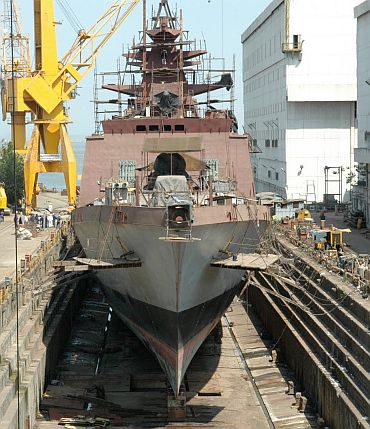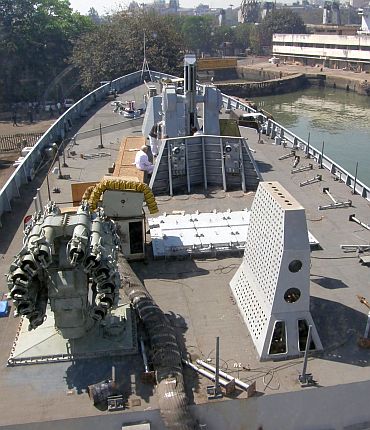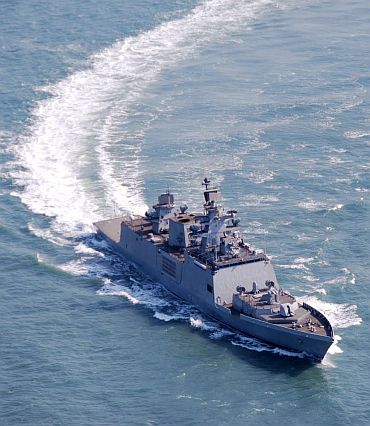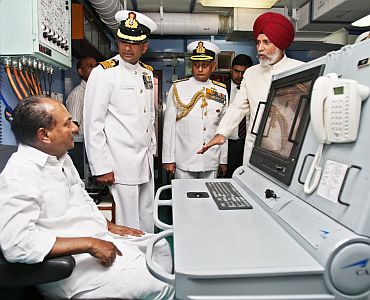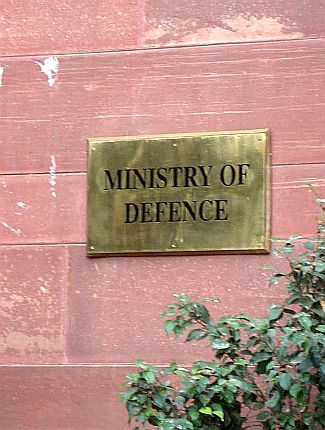 | « Back to article | Print this article |
The 'desi' warship is a deception, Mr Antony
The indigenisation programme of the ministry of defence has been an illusion, wrapped in a fallacy, cloaked in deception, writes Ajai Shukla
Defence indigenisation has long been more a ministry of defence slogan than reality. Minister A K Antony pays regular lip service to reversing the 70:30 ratio: i.e. reducing the foreign component of Indian defence from 70 per cent to 30 per cent. In practice, indigenisation has been an illusion, wrapped in a fallacy, cloaked in deception.
The empirical reality of "indigenisation" is evident in the Indian Navy, the only service that pursues indigenisation systematically (the Indian Air Force and the army talk the talk but oppose indigenisation in practice, demanding aircraft, tanks and guns now, not ten years down the line).
The navy takes justifiable pride in building most of its warships in Indian shipyards, but a closer examination reveals that indigenisation is only skin deep.
Defence shipyards have developed the crucial skills needed for designing and constructing sophisticated warships, and for harmonising myriad sensors and weapons into an integrated battle management system. But there is little headway in indigenising the multiplicity of components and systems that are the vital innards of a battleship.
Click on NEXT to read further...
Bulk of the systems for warships are sourced from overseas
Consequently, India's four defence shipyards --- the flagship Mazagon Dock Limited, Mumbai; Garden Reach Shipbuilders & Engineers, Kolkata; Goa Shipyard Limited; and the newly acquired Hindustan Shipyard Limited, Visakhapatnam -- must necessarily look overseas for the engines, gas turbines, propulsion systems, gearboxes, generators, hydraulic systems, air-conditioning and countless other systems, which add up to the bulk of the cost of modern warships.
These are all lost opportunities for India's private sector companies, which could be building these systems as their route into the lucrative business of defence production.
Examine the figures. From the navy's budget of Rs 21,000 crore this year (all figures rounded off), almost 60 per cent or Rs 12,000 crore is earmarked for capital expenditure. Of this, Rs 4,000 crore will be disbursed directly to foreign shipyards that are constructing Indian warships, while Rs 8,000 crore will be paid to Indian shipyards.
India imports 85 pc of the critical technologies
On the face of it, that would appear like a healthy 66 per cent indigenisation rate, close to Antony's target. Unfortunately, only a small share of this goes to the Indian shipbuilder.
MDL retains just 25 per cent of the cost of each warship it produces, with 75 per cent being paid to foreign suppliers for the systems mentioned above. GRSE pays out 65 per cent and GSL remits 55 per cent abroad, not because they are better at indigenising but because their vessels use lower-end technology that is available in India.
The shocking statistic is that India has a 100 per cent indigenisation rate in jungle boots and blankets and similar low-tech equipment.
But in critical technologies, we import 85 per cent of our needs. And in warship-grade and aerospace-grade components, we have indigenised just 5 per cent of our requirement; 95 per cent still comes from abroad.
Blame it on the Ministry of Defence
An example is Hindustan Aeronautics Limited's Dhruv helicopter, designed and integrated in India, but 90 per cent foreign in physical content.
This regrettable situation exists largely because the MoD, particularly its department of defence production, has failed to coordinate and sponsor the development of indigenous capability.
Warship builders still import even warship grade steel, the toughened alloy that comprises the basic structure of a modern battleship. This is not because the technology is beyond us.
Years ago, India's public sector metallurgical establishments -- the Defence Metallurgical Research Laboratory; Mishra Dhatu Nigam; and Steel Authority of India Limited -- developed and manufactured warship grade steel (termed D 40S), which has been used in the navy's reputed Shivalik class frigates.
Revising the targets
But cross-ministerial coordination is needed for producing the relatively small volumes needed for warship programmes while remaining profitable for both steelmaker and shipyard.
Essar Steel had offered to produce warship steel, subject to some conditions. But the MoD has preferred to continue reliance on import.
In 2003, the navy addressed the lack of depth in indigenisation with a '15 Year Indigenisation Plan', which was subsequently revised up to 2022.
This forecasts the warship programme's requirement of equipment and systems, hoping for import substitution by bringing in the private sector.
The funding is available, but...
A similar initiative last year, broadened to all three services, was the DRDO's "Technology Perspective & Capability Roadmap", which details the technologies that the military requires and urges the private sector "to offer firm commitments in partnering the MoD in developing contemporary and future technologies as well as productionalising equipment required by the armed forces."
But these useful baseline documents are only a starting point for an indigenisation thrust. Private sector corporations that are interested in defence production would still require handholding and funding for their initially non-productive R&D.
The funding is available -- each year the MoD has been earmarking some Rs 2,000 crore for "make" procedure projects, without a single rupee having ever been paid out -- but nobody in the MoD has taken clear ownership of such an initiative.
Time for MoD to step up to the plate
It is time for the defence ministry to step up to the plate.
They have already identified 61 critical technologies -- especially materials and components that can be used across a broad range of sub-systems and systems -- that India badly needs for developing higher technological capabilities.
A nationally synergised effort is needed, which must also explore the obtainment of specific technologies through the offset route.
We have learned how to swim at the deep end of the pool, developing the complex abilities needed for designing and integrating warships, aircraft and tanks, without developing the broader research and industrial eco-system that sustains a defence industrial base.
It is time to deepen and broaden indigenisation, developing the materials, components and sub-systems that will not just substitute defence imports, but also provide technological "trickle down" to energise the national industrial base.

